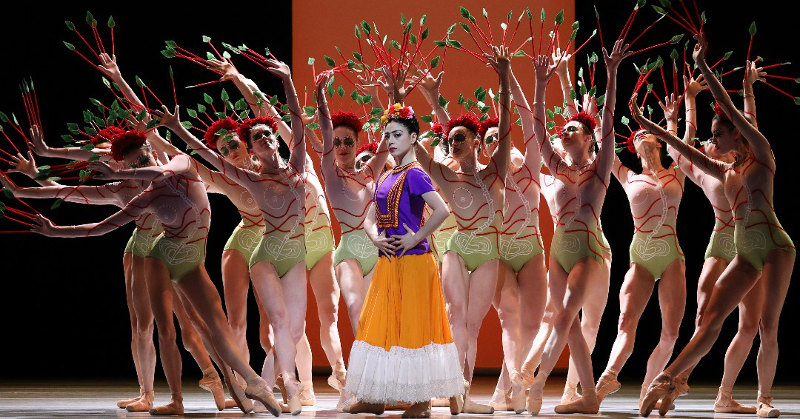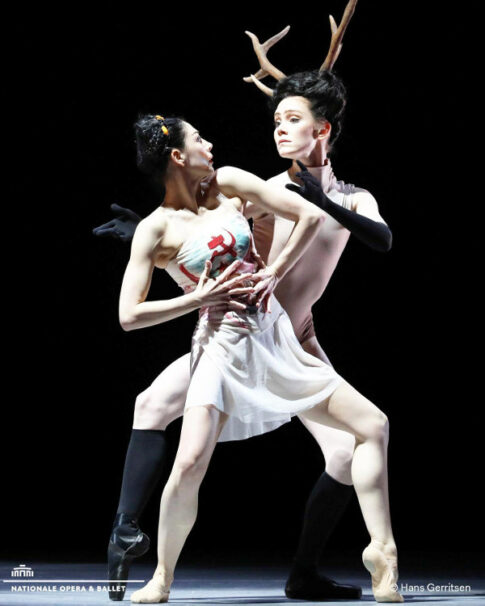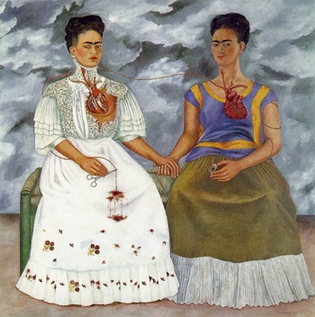
The deep fascination with the art and wrenching personal mythology of the great Mexican artist Frida Kahlo (1907- 54) found no better evidence than the fashion worn by the women of Los Angeles at the Dorothy Chandler Pavilion this weekend for “Frida,” the bio-ballet choreographed by Annabelle Lopez Ochoa for the Dutch National Ballet. Donning Kaholo-esque regalia were ladies across a spectrum of ages (even little girls). They wore colorful native skirts over flouncy cotton slips, black lacy shawls, hair pulled into tight, high buns, long dangle earrings. Flowers in hair festooned the entire look. It felt like International Women’s Day at the ballet, as fans and admirers channeled a feminist and artistic heroine whose life traversed an all-too-thin line between triumph and tragedy. There was much to admire in Ochoa’s ballet which is augured as a popular hit for the marvelous Dutch dancers. Well, they loved it in Los Angeles!
The two-act work is a build-out of a prior one-act, “Broken Wings” (2016), for the English National Ballet, also by the prodigious choreographer of Colombian/Belgian heritage. First danced in The Netherlands in 2020, Los Angeles hosted its U.S. premiere — a feather in the cap of ‘Glorya Kaufman Presents Dance at the Music Center’ President & CEO Rachel Moore. Meanwhile, the choreographer, in New Zealand at work on her next piece, chimed in her support via social media. The dancers did Ochoa proud, along with company Artistic Director Ted Brandsen, who commissioned the full ballet and was in the house at The Music Center.

“Frida”‘s pleasingly tight first act is a tour-de-force. Helpful program notes by dramaturg Nancy Meckler, a frequent Ochoa collaborator, guides the viewer through the high and low points of Kahlo’s familiar trajectory; within minutes of the ballet’s start, we see a powerful (if minimalist) rendering of her notorious trolley-car accident. This immediately plunges us into tragic territory, as the young lady in school-girl garb is already the survivor of childhood polio. We see her beginnings as a hobbyist/painter dabbing self portraits from her bed; her bold flirtation with the older, established artist, Diego Rivera; finally the first act closes with the miscarriage that woefully stems from their union. Peter Salem’s perky score with dark undertones does not stint on the sounds of Mexicanismo — the mandolin, harp, guitar, claves, flute, snare drum, even a lub-dub heartbeat sent forth from the Chandler orchestra pit whose live musicians Matthew Rowe ably conducted.
It is impossible to extricate this ballet from its production elements, so closely entwined with the choreography they are. Active, moveable black-box props by designer Dieuweke Van Reij add forcefully to the “Frida”‘s theatrical magic. When cracked open, the boxes house discrete playlets: Kahlo’s sick bed, her art studio and that of Rivera. These props and effects lend “Frida” form, shape and focus that choreographers rarely have the time or envision. Just brilliant is a parade of flat, front-facing gold-wire sculptures ported across the stage to evoke the Mexico City traffic in which Kahlo’s body gets strewn (I wouldn’t have minded seeing those sculptures again.) A rambling branch of colorful blossoms, hung on high, designer Michael Mazzola bathed in clarifying white light. Within that heavenly glow danced a female corps de ballet in costumes that (for me) hearkened the ballet surrealists of the ’30s and ’40s — dancers as trees with leaves springing from head and elongated fingers. Other of Van Reij’s costumes — the antlered deer and fluttering bird — vivified painted icons flowing from Kahlo’s febrile imagination. Never seen in a ballet — but then again, that stuff was unseen in a painting until the artist superimposed her face on a deer’s body with antlers sprouting from her head.
The melding of all these elements had “Frida” spooling like a picture book for adults, as it coursed through grown-up emotions of passion, betrayal, ambition, revenge, and unvarnished despair. My favorite scenario had Rivera, in his studio, flirting and philandering with his two leggy models, while Kahlo, paired on stage in her own studio, is shown to be broken, struggling, feeling his betrayal, before images of “The Two Fridas.” Heart-rending. But so good.
Ochoa choreographs splendid pas de deuxs for Rivera and Kahlo. I saw two world-class ballerinas dance the Frida role: Maia Makhateli, whose acting skills surpassed those of Salome Leverashvili, the latter a gorgeous dance technician but overly dour, kind of glarey. In the duets, Fridita, as Kahlo was lovingly nicknamed, parries with paramour Diego Rivera (the well-named James Stout, in a “fat suit,” Artur Shesterikov in his ballet bow-out, retiring after sixteen years with Dutch National Ballet). This first duet is an Ochoa gem. Frida flits-and-flirts with the stolid Rivera, who is shown to be confused, insecure, off balance initially; but succumbing, he swoops the petite Kahlo in circles low to the ground.
I had quibbles. The toilet overhang in the Manhattan scene must go. (I’m hoping it didn’t make it to LAX.) The hanging skirt in the same scene needs to be larger — doesn’t register. Both images appear in Kahlo paintings, of course. I appreciated the presence of two large Greek choruses doing stagecraft-handiwork, as well as dancing as corps de ballets: a crew of skeletons whose black trousers were cleverly lined in mariachi studs and the all-male “Ten Fridas,” who had me on the fence at first viewing, but grew on me by the second. The choreography, especially for the “Ten Fridas’ seemed perfunctory at times, but altogether Ochoa applied wit, invention, and beauty of movement on stage. I do wish that a dancer of Latin origin had played Diego Rivera; James Stout did a good job, his messy head of hair topping his pot belly’ed brown suit, something new and fun to watch. But an element was missing — I feel that Rivera radiated machismo, something endemic to Mexican men of his era. We see Kahlo as a sexual vixen — what about her partner?
Diego and Frida’s long sojourn in New York City is a tempting tale. But gosh, that’s Rivera’s story, not Kahlo’s. It bothered me that Diego’s failed mural for Rockefeller Center was replicated in large scale in Frida’s ballet. Also bothersome was that the New York scene was used to show Kahlo’s extramarital affair with a photo-journalist (although I enjoyed their soft, sensual dancing). There’s just not enough in “Frida” about Kahlo the artist, however crazy that seems to say. The “Tree of Life” scene pictured above was a beautiful dancing canvas, but I wanted more. Kahlo’s astonishing “The Two Fridas” (1939) had way-too-muffled a life on stage. This is one of the most mysterious, evocative and powerful paintings, ever, by a female artist, and among the most admired artworks of the 20th century. As for the danced version of Khalo’s , “The Broken Column” by a tall blonde ballerina, well, that did not work.

Ochoa rendered the disabled Kahlo in broken disjunctive body positions, memorably, a penche arabesque against a wall with the upper leg ‘broken’ down. We saw her limping in her soft slippers. “Able-ism” is a thing, now, in the dance world, with many choreographers working with dancers of a variety of handicaps. A more contemporary take on Kahlo’s disability seemed missing.
Altogether, the ballet’s level of excellence dropped from the first to the second act. I was left wondering if Ochoa couldn’t have abandoned Kahlo’s dismal denouement altogether and instead spotlighted her majesty: her work. I would have thoroughly enjoyed three or four tableaux vivant of Kahlo canvasses. That would have divorced “Frida” the ballet from victimhood, which is essentially where the ballet positions her, and left her basking glorious living color. It’s art, it’s made up, and we’re allowed to change the ending. Speaking of color, where was the Casa Azul?
Arts journalist Debra Levine celebrated fifteen years of fine-arts blogging on arts●meme in 2023.
